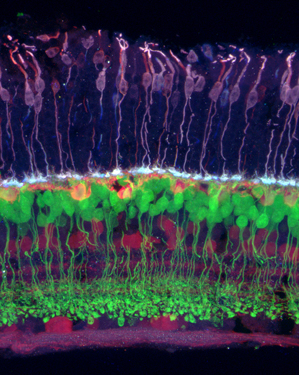The U.S. announces $46 million to develop new technologies for exploring the brain.
Why It Matters
The three-pound mass between our ears is the next great frontier for science.

The retinal nerve cells shown in this close-up transmit information to the brain.
The White House said that President Obama’s BRAIN Initiative is generating interest from companies and philanthropies in a sign of what it calls a wider partnership developing around the U.S. administration’s most prominent science initiative, first unveiled in 2013.
The White House had committed to spending $100 million this year on the project, which seeks to develop new technologies for studying the brain. As part of that, today the U.S. National Institutes of Health announced $46 million in awards to 58 research groups.
The diverse technologies the NIH is backing include development of a wearable PET scanner, which could monitor patients’ brains during everyday activities, lasers able to control how neurons fire, and diamond-coated electrodes that can detect the neurotransmitter dopamine in living brains.
During a press briefing, NIH director Francis Collins said the research grants would speed the “development of exciting new tools and technologies to understand how [brain] circuits work.” He said the BRAIN Initiative could spend $4.5 billion on such neurotechnologies over the next decade or so.
The effort, whose full name is Brain Research through Advancing Innovative Neurotechnologies, reflects a government strategy to invest widely in better techniques to measure the brain. That’s necessary not only because the brain’s functioning remains enigmatic, but because it is difficult to study neurons in living animals, limiting scientific progress.
Collins compared the NIH’s approach to that taken during the Human Genome Project, which he also oversaw starting in 1999. That effort was vastly accelerated thanks to better technology for sequencing DNA. “There was a lot of uncertainty, but it worked out,” said Collins. “No one can quite predict the twists and turns.”
But the brain is so much more complex than DNA that several scientists said the role for technology is not as clear cut this time. “With the Genome Project, we knew what the technology needed to be. Here, we are not even sure what technologies are most useful because the questions still need to be defined,” says Gerald Fischbach, scientific director of the Simons Foundation, a private charity in New York that is investing millions in brain science. Fischbach was not part of the NIH announcement.
Around the world, other large neuroscience efforts have also had to pick where to place their bets. In Europe, a heavily-funded Human Brain Project is seeking to create large-scale computer simulations of the human brain, although that strategy that has been criticized as premature (see “Neuroscientists Object to Europe’s Human Brain Project”).
One reason the U.S. project doesn’t satisfy all neuroscientists is that it strongly embraces the idea that there are “circuits” in the brain, or that one neuron would excite another, and so on, leading to behaviors. While that certainly happens, some say the circuit analogy is an antiquated anatomical notion insufficient to explain how the 86 billion neurons in the brain actually operate.
“But generating data is a good first step,” says Konrad Kording, a neuroscientist at Northwestern University.
The grants announced by the NIH support development of some proven technologies, such as optogenetics, a technique to turn neurons on and off in lab animals using light pulses. Elsewhere, the agency took bigger risks, like the $539,000 it awarded to develop a wearable PET scanner whose “ultimate goal is to be able to image subjects during a proverbial ‘walk in the park’ and other natural activities,” according to West Virginia University’s Julie-Anne Brefczynski-Lewis, who is one of about 100 scientists who will share in the NIH awards.
Separately, the White House held an event to highlight its efforts and what it calls $300 million in ongoing private R&D investments in brain science. Groups attending today’s White House event included the Simons Foundation, which this year independently announced plans to spend $62 million to understand how brains generate thought. Fischbach says that by convening different groups, the White House hoped to demonstrate that “we can benefit from, or help the Obama initiative.”
“I don’t know what is cause and what is effect, but it’s a definitely hot area,” he says. “There has been an upswing in this type of neuroscience, which is really quite remarkable.”

Nenhum comentário:
Postar um comentário
Observação: somente um membro deste blog pode postar um comentário.